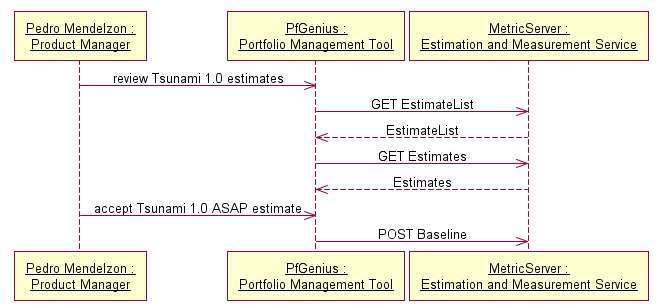Initiating a project: Act 1. Setup, Act 2. Estimation, Act 3. Completion, Investment Risk, Summary
Contents
Project Prioritization and Selection
Summary Sequence Diagram
Completing the Project Initiation Process
At this point, PfGenius has sent Pedro a notification that the estimates have been completed and are ready for review. Pedro logs in to PfGenius, opens the Tsunami 1.0 project, invokes the “Review Estimates” command.
Using EMS 1.0
PfGenius again sends requests to MetricServer to get the estimates. This is accomplished by sending a GET request to the EstimateList URI, specifying that only the estimates for Project 4201 are desired. The following URI produces the desired list of estimates:
http://braintwistors.example.com/ems10/Estimate?oslc.where=ems:scenario{ems:project{dc:identifier=4201}}
In our example there is only one estimate in this list. PfGenius then GETs that Estimate and presents it to Pedro.
Evaluating the Project Proposal
Pedro next computes the development cost, e.g. by applying a labour rate to the effort estimate. The business value of the project is computed by subtracting the cost from the benefit.
BrainTwistors Corp. uses a standard labour rate of 150,000 USD/person-year:
rate = 150,000 USD/person-year
The development cost is therefore:
cost = effort * rate
= (25 person-month) * (150,000 USD/person-year) / (12 month/year)
= 312,500 USD
The business value is the difference between the benefit and the cost:
value = benefit - cost
= (500,000 USD) - (312,500 USD)
= 187,500 USD
The business value is well into the positive range so Pedro accepts this estimate and completes the business case for the proposal.
The Baseline Resource
During the course of a project, actual performance is compared to a baseline in order to determine if the project is on track. The most common types of baseline are for schedule and cost. In software projects, the size, quality, and other metric estimates may also part of the baseline. At project initiation, the assumptions and estimates that go into the business case upon which the project is approved become the initial baseline. As the project progresses, the project may be reestimated and new baselines created. The baselines should converge as the project progresses.
In our example, when Pedro accepts the estimate for the Tsunami 1.0 project, PfGenious creates a new Baseline resource for the project using EMS 1.0. The Service resource has an ems:baselineList property whose value is the URI of the BaselineList resource. PfGenious POSTs a representation of the Baseline resource to the BaselineList URI. The following listing shows the representation of the initial Baseline resource for Project 4201:
Listing of ASAP Baseline Resource Representation
<?xml version="1.0"?>
<ems:Baseline xmlns:rdf="http://www.w3.org/1999/02/22-rdf-syntax-ns#"
xmlns:dcterms="http://purl.org/dc/terms/" xmlns:ems="http://open-services.net/ns/ems#">
<dcterms:title rdf:parseType="Literal">Initial Baseline for Tsunami 1.0
</dcterms:title>
<dcterms:description rdf:parseType="Literal">
Deliver ASAP. Duration 6
months. Guestimator 101
predicts 25 person-months.
</dcterms:description>
<ems:project rdf:resource="http://braintwistors.example.com/ems10/Project/4201" />
<ems:scenario rdf:resource="http://braintwistors.example.com/ems10/Scenario/5721" />
<ems:estimate rdf:resource="http://braintwistors.example.com/ems10/Estimate/6648" />
<!--
Other properties of this resource have been omitted for brevity.
-->
</ems:Baseline>
In general, a baseline is for a specific project. It may contain a scenario, and a set of zero or more estimates for that scenario.
Project Prioritization and Selection
Business value is used as one criterion in the project priorization process. Strategic alignment is also considered when prioritizing. In our example, the Tsunami 1.0 proposal aligns with the BrainTwistors Corp. strategic goal of growing the business. During the prioritization process, the Tsunami 1.0 proposal ranks high and gets approved. The proposal is then sent into a software project management system for execution. Project execution will be covered in another scenario.
Summary Sequence Diagram
The following sequence diagram summarizes Act 3:

The examples up till this point gave the assumptions and predictions as single, definite numbers. In reality, these quantities are only approximately known and they should be given as probability distributions that convey our level of uncertainty about them. This uncertainty contributes to the investment risk of the project which is our next topic.
Next: Investment Risk
Previous: Act 2. Estimation
Category:EMS Primer





